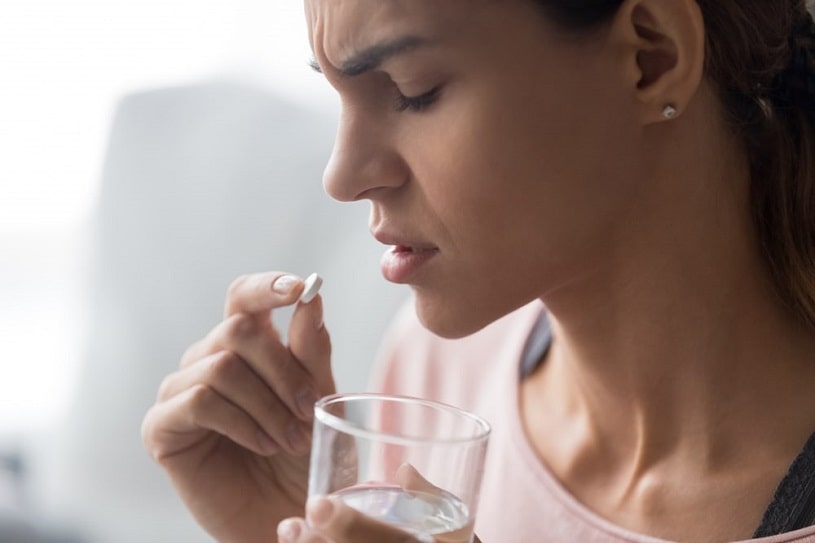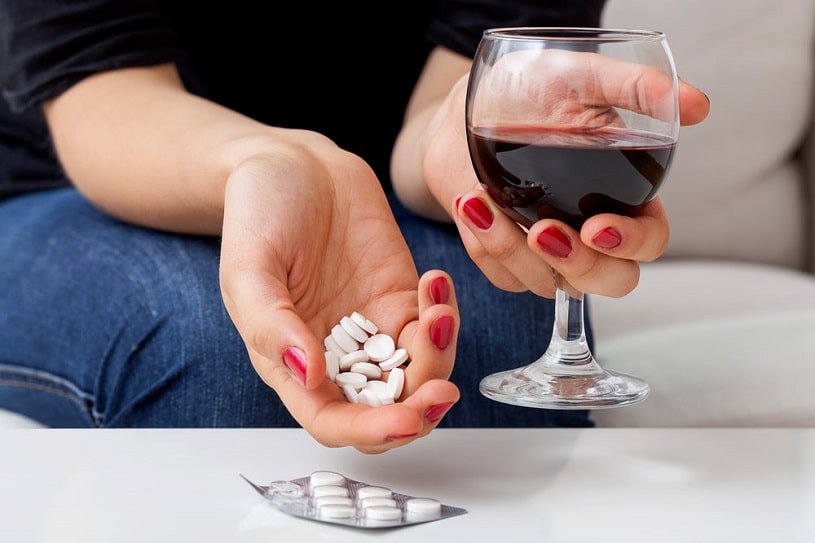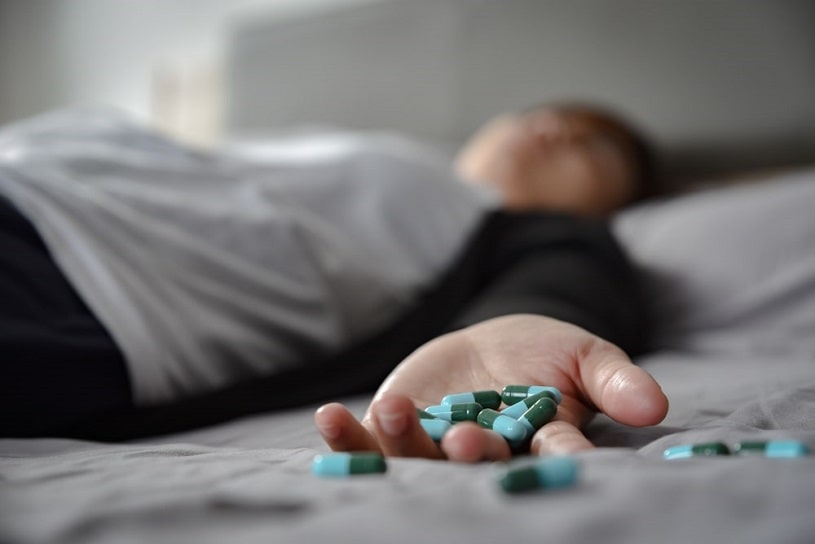In the US, approximately 4.7 million people are addicted to different types of painkillers. Vicodin addiction accounts for nearly half of the number, with two million individuals who are physically or psychologically dependent on the medication.
Learn more about the physical and behavioral signs of Vicodin addiction, along with the signs of overdose, and withdrawal symptoms from it. Discover the detoxification process and opioid addiction treatment options.
Table Of Contents:
Vicodin Drug Overview
Vicodin Is a Prescription Painkiller Made Of Hydrocodone and Acetaminophen:
- Hydrocodone is a synthetic drug used to suppress the brain’s pain transmitters so that the person who takes the drug does not feel any pain after medical processes such as surgeries.
- Acetaminophen is a common analgesic that is also given to patients who complain of surgery or injury-related pain.
Vicodin is a highly addictive drug because of its powerful pain-relieving effects. Once taken internally, it stops the brain from transmitting signals related to pain, and at the same time, ups the person’s dopamine levels to make him or her feel euphoric. As with many other addictive drugs, the body easily develops a tolerance to the amount of the drug being taken.
This results in the need for higher doses to achieve the same satisfying effects. Even with a proper prescription from a physician, an individual is at a high risk of getting addicted to the opioid.
Hydrocodone as a main component of Vicodin acts by activating special receptors found in the brain called mu-opioid receptors.
This Activation Leads To Two Important Mechanisms Within the Brain:
- Inhibition of nociceptive pain signals (pain caused by injury to body tissues), which travel along sensory nerves to the brain
- Inhibition of substance P release is an important neurotransmitter that is believed to be responsible for transmitting pain within the central nervous system (CNS)
Acetaminophen, on the other hand, is not fully understood but is believed to carry out its two important functions as a painkiller and antipyretic in the following ways:
- It provides mild to moderate analgesia by activating certain inhibitory pathways in the CNS.
- Its antipyretic effects occur by inhibiting the hypothalamic heat-regulating center via the release of certain important substances called prostaglandins.
Is Vicodin an Opioid?
Yes, Vicodin is an opioid. It is classified as a schedule II drug. This means it has a high potential for abuse, and can lead to severe psychological or physical dependence, especially when the products are not used as prescribed. Schedule II drugs can be purchased at a pharmacy with a prescription but cannot be dispensed over-the-counter (OTC).
Vicodin Side Effects
Vicodin’s purpose is to relieve pain and to suppress the cough reflex. In controlled doses, the two substances relieve mild and moderate pain. However, in two large amounts, both substances can cause serious damage. The severity of the side effects depends on the dose, ranging from immediate feelings of euphoria and nausea to kidney failure and death.
Common Vicodin Side Effects
Patients that take this medication and strictly observe the doctor’s consumption guidelines should not experience side effects. Vicodin is a medicine that should be taken only for a short amount of time. This is because hydrocodone is potentially addictive, which can make it difficult to stop taking the analgesic. Prolonged use of that medicine can have many more harmful effects.
Taking Vicodin Causes Such Side Effects As:
- Anxiety
- Inability to focus
- Confusion and impaired judgment
- Mood Swings
- Profound drowsiness
- Dizziness
- Loss of consciousness
- Ringing in the ears
- Slow heartbeat
- A decrease in breathing rate
- Headaches
- Seizures
- Itching
- Weakness
- Nausea
- Dry Mouth
- Vomiting
- Stomach issues and difficulty excreting
- Constipation
Confusion and hallucinations are also common effects of the drug.
If one is a regular patient taking the drug as a painkiller, and recognizes these side effects, talk to a doctor. It may be that the dose is too high or that the medication should be changed.
What Are the Long-term Side Effects Of Vicodin Addiction?
There are specific reasons why doctors don’t prescribe hydrocodone/acetaminophen for long-term use.
Tolerance
After some time, the patient’s body increases its tolerance to hydrocodone. That means that the body adapts its receptors to be less sensitive to the drug molecules. As a result, the current hydrocodone amounts in the Vicodin doses are no longer sufficient to relieve pain. The patient then has to increase the dose.
That is the first step to becoming physically dependent on the drug.
Risk of addiction
Like in the case of other opioids, physical dependence usually also leads to psychological addiction. More than only trying to relieve pain, people start craving Vicodin and obsessing over it. Even if they are aware of the dangers, they disregard them, prioritizing the immediate sensations the drug provides.
Long-Term Intake Can Lead to:
- Liver damage
- Jaundice
- Poor work and school performance
- Financial and relationship issues
- Coma
- Death
Vicodin Addiction
Prescription opioid abuse and misuse is a very serious problem in the United states. In 2017 the number of people misusing prescription medications was estimated at 18 million. More than 6 percent of those are aged 12 or older. Misuse of prescription drugs is highest among young adults ages 18 to 25.
As the National Survey on Drug Use and Health reports in 2017, around 2 million Americans misused prescription pain relievers for the first time within the past year, which averages to approximately 5,480 initiates per day.
About 2 percent of high school seniors reported past-year nonmedical use of the opioid pain reliever Vicodin.
Vicodin Addiction Symptoms
Opioid addiction presents various telltale signs and symptoms. This information can help identify opioid abuse early on.
Here are a few physical and behavioral symptoms to look out for in case of potential opiate abuse.
Some Physical Signs Of Vicodin Addiction Include:
- Frequent flu-like symptoms such as chills, sweats, vomiting, nausea, and generally poor health.
- Reduced hygiene
- Rapid unintentional weight loss
- Drowsiness
- Muscular pain and tremors when the drug is not taken
- Shallow or slow breathing rate
- Constipation
- Physical agitation
- Poor coordination
- Slurred speech
Behavioral Changes Seen in Vicodin Addiction May Include:
- Shopping for physicians who will give additional hydrocodone prescriptions
- Use of the drug for the very least of pain felt
- Suffering severe mood swings when the drug is not taken
- Consuming more units than prescribed
- Continuing to use the drug despite harmful Vicodin side effects on the body
- Spending much time on activities to acquire the drug
- New financial difficulties
- Change in sleeping habits
- Irritability
- Reduced libido
- Depression and reduced motivation
- Anxiety attacks
Vicodin and Alcohol Interaction
Mixing Vicodin with alcohol is strongly not recommended and poses a serious risk to the user’s health. Vicodin and alcohol both act as depressants of the CNS, which is in charge of many important bodily functions, including breathing.
When taken together, their combined effect may depress the respiratory centers of the brain to the point that the user’s brains fail to send signals to the body to breathe, leading to death. This is the most common cause of death from Vicodin and alcohol abuse.
Even if it Does not Lead to the Extreme Of Death, Other Possible Consequences Are:
- Drowsiness
- Dizziness
- Increased risk of an overdose
- Difficulty breathing
- Impaired motor control
- Potentially long-lasting memory problems
Those who struggle with alcohol dependence, senile individuals, people who abuse other prescription products, and suicidal individuals have a higher risk of mixing opioid painkillers with alcohol. Therefore they should be closely monitored for any signs of substance abuse and their medication dispensed carefully.
Vicodin Overdose
As a prescribed painkiller, Vicodin has its merits. However, it should be used in moderation.
This means that a patient can overdose, build up a tolerance, and become dependent on it, along with many other side effects. In the case of Vicodin, one can sustain serious damage to the liver and overdose on small amounts of the drug.
It is important always to stick to the dose prescribed and never adjust it without a doctor’s consultation.
In the hope of preventing a Vicodin overdose, the drug was moved from a Class C to Class B substance in 2014. This helps to place limits on the amount of the drug sold and where it can be sold. By doing this, governments can monitor the amount of Vicodin taken by individuals and prevent people from suffering the effects and side effects of taking too much.
Overdose due to Vicodin ingestion leads to a combination of adverse consequences of hydrocodone and acetaminophen use.
What Are the symptoms Of a Hydrocodone Overdose?
Hydrocodone Overdose Symptoms Include:
- Respiratory depression
- A cold, clammy skin
- A state of somnolence that can turn into stupor or coma
- Flaccidity of skeletal muscles
- Hypotension and bradycardia may not occur but are signs of a dangerously high hydrocodone level in the body
- If one experiences or witnesses these symptoms in someone else, there is a need to stay vigilant
In Сases Of Severe Overdosage, the Person is at an Additional Risk of:
- Respiratory troubles that can lead to a complete suspension of breathing or apnea
- A sudden decrease in blood pressure resulting in a circulatory collapse and cardiac arrest that can lead to death
What Are the Symptoms Of Acetaminophen Overdose?
Acetaminophen Overdose Symptoms Include:
- Hypoglycemic coma- a deficient blood sugar level can induce the loss of consciousness and even a coma
- Kidney failure or renal tubular necrosis
- Coagulation and blood clots
- Hepatic failure, leading to hepatic necrosis, a severe injury to the liver
Even a single overdose of the drug can be potentially lethal.
Vicodin Withdrawal: Symptoms, Timeline, and Detox
It happens when one stops taking Vicodin after completing the course of treatment or as a part of detox. The level of the substance in the blood falls. It causes a set of unpleasant or sometimes serious effects. These effects are withdrawal symptoms. The withdrawal symptoms are similar to those of the other opiates such as Morphine, Codeine, and Hydromorphone.
Watch These Vicodin Withdrawal Symptoms and Act Fast
Initially, withdrawal symptoms mimic those of the flu. This is one of the reasons why one may fail to identify dependence or if it’s developing.
Over Time, Patients May Experience One or More of the Following:
- Anxiety and restlessness
- Unstable mood
- Inability to fall asleep or maintain sleep
- Sweating
- Increased nasal secretion
- Pain in muscle
- Shakiness
- Nausea and vomiting
- Diarrhea
- Increased cravings
Users may experience some of the above within a few hours or days after stopping Vicodin. If it happens, one should talk to a doctor right away. Patients will need to know if they are due to drug dependence. It is always a good idea to take note of the signs. This is especially after one has stopped taking drugs and because of the high addiction potential. Early diagnosis and prompt treatment make the withdrawal symptoms more manageable. Furthermore, it decreases the risk of complications and long-term addiction.
Vicodin Withdrawal Timeline: How Long Will It Last?
Hydrocodone withdrawal is a very subjective experience. Furthermore, how long the process lasts can be very different between people. For some, it may last just for a few days, while others may experience the symptoms for weeks or even months. Therefore, it is challenging to set the timeline for withdrawal exactly.
One can link the half-life of the drug to the appearance of withdrawal symptoms. A drug with a longer half-life leaves the bloodstream more slowly, thus delaying the withdrawal. In contrast, drugs having a short half-life leave the bloodstream early. As a result, withdrawal can occur much faster. Generally, hydrocodone withdrawal symptoms begin 6 to 12 hours after the last dose.
Here Is a Quick View Of the Withdrawal Timeline:
| DAYS | SYMPTOMS | SEVERITY | REMARKS |
|---|---|---|---|
| DAY 1 | Muscle pain, joint pain, nausea, vomiting, and sweating | Moderate | This phase of Vicodin withdrawal mainly consists of physiological symptoms |
| DAY 3-5 | Diarrhea, Vomiting, Excessive sweating, tremors, and continued muscle aches | High | This is the peak and the most uncomfortable phase of the withdrawal. The strong urges to get back to the addiction can ruin all the efforts for a drug-free life |
| DAY 6-7 | Most physiological symptoms should have subsided by now. Psychological symptoms such as craving, anxiety, and depression may persist | Moderate | This phase is more troublesome to the mind than the body. |
| MORE THAN 7 | Anxiety and mood problems may linger for the next few weeks or even a month | Moderate | These symptoms do not cause much worry as long as one maintains the normal routine and treatment guidelines |
Vicodin Addiction Treatment and Detox
There are several options available for people suffering from Vicodin addiction. The longer one abuses the drug, the more damage a person will face shortly before Vicodin leaves the system. Medical specialists are here to help patients overcome the addiction and unpleasant withdrawal symptoms and make recovery easier.
Weaning Off Vicodin
Generally, the doses are gradually reduced in an attempt to wean the patient off the drug. This way, they experience the least withdrawal symptoms possible. Furthermore, drugs such as methadone may be used in small doses to help replace the opioid without the negative side effects. The detox process varies depending on the level of addiction the patient has and their personal choices on whether they want to try a rapid or traditional detox.
Note that weaning off should only happen under the supervision of doctors.
Vicodin Detox
Drug detox is a short-term program which tries to remove as much drug from the bloodstream as possible. As the drug starts leaving the body, a patient will experience several undesirable symptoms. Doctors can help alleviate many of these symptoms by prescribing medications. They will act especially against the drug effects or produce similar but milder effects.
Rapid Detox
Those who haven’t been addicted for as long or as drastically can go on a rapid detox program, which is completed in hours under the influence of anesthesia. However, these patients are still encouraged to contact medical professionals, keeping them updated on their progress after the treatment. This process allows patients to avoid most of the negative symptoms of withdrawal due to anesthesia.
Results for rapid detox are very mixed, with good short-term effects but far fewer patients succeeding in their quest to stay sober long-term.
Furthermore, costs and medical conditions prevent many patients from undergoing rapid detox, especially talking about long term addicts.
There are also various degrees of aftercare, which are highly recommended. Specific living environments with no exposure to the drug, counseling, or meetups with fellow former addicts enable the recovering patients to discuss progress and prevent potential relapses.
Medical Detox: Which Medications Are Used To Detox From Vicodin?
Medical detox uses medications to treat symptoms of withdrawal . The US FDA has approved the use of opioid antagonists such as Buprenorphine and Methadone during a Vicodin detox.
Buprenorphine is a partial opioid agonist, unlike Hydrocodone. It is less addictive and produces milder effects. It provides relief from the symptoms of hydrocodone withdrawal and also reduces cravings. Methadone is a US FDA-approved opioid medication for Vicodin detox.
A doctor may prescribe medications like antidepressants for anxiety and mood-stabilizing agents for mood swings. This is to manage other Vicodin withdrawal symptoms.
How Long Does It Take To Detox From Vicodin?
Every case of addiction is unique. One individual’s response to the drug or its treatment may not match that of another. Therefore, it is difficult to set a time frame for the detox from Vicodin exactly. The duration of the detox will last as long as the withdrawal symptoms remain with the patient. Once the detox is over, the patient can switch to other long-term rehabilitation programs to prevent relapse.
Having a range of different approaches gives patients more control and the detox they want. Thus, they are more likely to succeed in their attempt to conquer addiction. Medical professionals also offer their opinion on which treatment they believe is best for each patient and why.
Finding Addiction Treatment
If one is addicted to hydrocodone or knows someone struggling with addiction, it is crucial to get help immediately. Quitting on your own may mean serious withdrawal symptoms that can hurt a person, family, and entire life. Additionally, since the drug is so powerful, striving to quit on your own can only go to waste due to the high probability of having a relapse.
Receiving proper addiction treatment via an inpatient rehabilitation program will ensure that every step one makes leads to complete healing. Inpatient drug rehabs use medically proven processes that involve detoxification and weaning from the drug, as well as behavioral therapies that will set one free from dependence and obsession towards such a dangerous substance.
Page Sources
- Hydrocodone and Acetaminophen. Habibi M, Kim PY. 2020. https://www.ncbi.nlm.nih.gov/books/NBK538530/
- Opioid Misuse and Addiction. https://medlineplus.gov/opioidmisuseandaddiction.html
- National Institute on Alcohol Abuse and Alcoholism. Harmful Interactions. Mixing Alcohol With Medicines. https://www.niaaa.nih.gov/publications/brochures-and-fact-sheets/harmful-interactions-mixing-alcohol-with-medicines
- Medline Plus. Opiate and opioid withdrawal. 2019. https://medlineplus.gov/ency/article/000949.htm.
- Krashin D., Murinova N., Trescot A. M. Extended-release hydrocodone – gift or curse?. Journal of Pain Research. 2013; 6: 53–57. doi:10.2147/JPR.S33062. https://www.ncbi.nlm.nih.gov/pmc/articles/PMC3555555/.
- Narconon. Signs and Symptoms of Vicodin Abuse. https://www.narconon.org/drug-abuse/signs-symptoms-vicodin.html.
- National Institute on Drug Abuse. Monitoring the Future 2018 Survey Results. 2018. https://www.drugabuse.gov/related-topics/trends-statistics/infographics/monitoring-future-2018-survey-results.
- Volkow N. D. Teen prescription drug abuse is a major health concern. Tennessee Medical Association. 2009; 102(4): 28–29. https://www.ncbi.nlm.nih.gov/pmc/articles/PMC4827331/
- Drug Enforcement Administration. Hydrocodone. 2018. https://www.deadiversion.usdoj.gov/drug_chem_info/hydrocodone.pdf.
- National Institute on Drug Abuse. Opioids. https://www.drugabuse.gov/drug-topics/opioids.
- U.S. Department of Health and Human Services. What are Opioids? https://www.hhs.gov/opioids/prevention/index.html.
- Centers for Disease Control and Prevention. Vital Signs: Variation Among States in Prescribing of Opioid Pain Relievers and Benzodiazepines — United States, 2012. https://www.cdc.gov/mmwr/preview/mmwrhtml/mm6326a2.htm?s_cid=mm6326a2_w.
- Drug Enforcement Administration. Hydrocodone. 2019. https://www.deadiversion.usdoj.gov/drug_chem_info/hydrocodone.pdf.
- NCBI. Hydrocodone and Acetaminophen. 2020. https://www.ncbi.nlm.nih.gov/books/NBK538530/.
- Medline Plus. Hydrocodone. 2019 https://medlineplus.gov/druginfo/meds/a614045.html.

 Authored by
Authored by  Reviewed by
Reviewed by 





